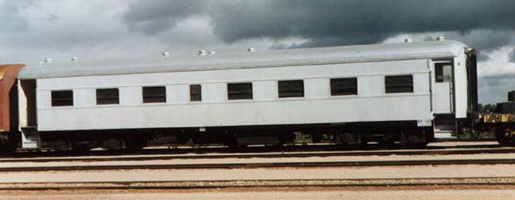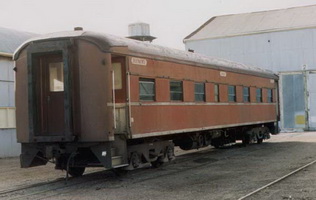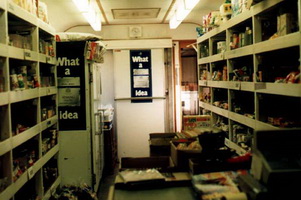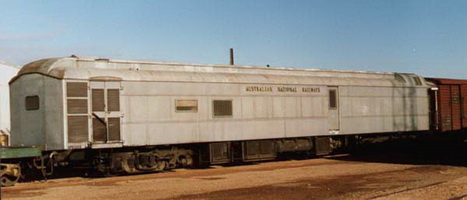
In 1978, the Commonwealth, South Australian and Tasmanian Railways amalgamated to become what is now Australian National (AN). In the years since the amalgamation many items of the South Australian Railways (SAR) passenger rollingstock have been transferred to run on the former Commonwealth Railways (CR) lines. But this is not the first instance of SAR rollingstock finding their way onto CR tracks.
| SAR No. | CR No. | Ent.Serv | Writ.Off |
|---|---|---|---|
| 119 | NAP 1 | 4.1890 | 23.10.1933 |
| 94 | NABP 2 | 4.1888 | 23.04.1934 |
| 95 | NBP 3 | 4.1888 | 1954 |
| 126 | NBP 4 | 4.1890 | 1954 |
| 98 | NHS 1 | 4.1888 | |
| 99 | NHS 2 | 7.1888 |
This began initially as a result of the Northern Territory Acceptance Act of 1910, when the CR took over control of the Palmerston and Oodnadatta railways from the South Australian Government. With the take over of the Palmerston to Pine Creek line, the rollingstock then in use was sold to the Commonwealth. It was considered cheaper to do this than to return it to South Australia. The rollingstock included four narrow gauge lavatory cars which were recoded NAP1, NABP2, NBP3, NBP4 and two four wheel combination brake and luggage vans which became NHS class number 1 and 2. All six vehicles were condemned long ago, being either destroyed by fire or the ravages of time.

With the handover of the Oodnadatta Railway, in 1926, very little SAR rollingstock was made available for sale to the Commonwealth. Instead the SAR transferred most of the items to other regions of their narrow gauge system. The Commonwealth Railways constructed their own rollingstock and only purchased five 44ft. relay vans, (which became NHBR cars 18 to 23), one sleeping car (Wanilla) and the Steam Motor Coach known as the Coffee Pot. The sums requested of the Commonwealth by the SAR was as follows
This was considered reasonable, being £3,433 less than the original cost of the vehicles and £7,911 less than the price SAR Commissioner W.A.Webb had asked for them in March 1922. All seven vehicles were handed over, in working order, on 1/1/1926 when the Commonwealth took possession of the Oodnadatta line.
Wanilla was a bogie sleeping car built by the Adelaide Locomotive workshops of the SAR and issued to service on the northern system in 1889 as car number 110. It was named Wanilla in 1917 and when sold to the Commonwealth Railways in 1926 was recoded NRP24. It was subsequently used in regular service as an Inspection and general passenger car on the Ghan and Chaser services of the Central Australia Railway (CAR), until written off in 1963.
| SAR No. | CR No. | Ent.Serv | Writ.Off |
|---|---|---|---|
| 1050 | NHBR 19 | 6.1908 | 28.10.1963 |
| 1090 | NHBR 20 | 6.1908 | 26.02.1964 |
| 1142 | NHBR 21 | 6.1908 | 1969 |
| 5646 | NHBR 22 | 6.1916 | |
| 5647 | NHBR 23 | 6.1916 | 27.05.1969 |
| 110 | NRP 24 | 12.1889 | 13.09.1963 |
Steam Motor Coach No.1 was officially recoded NJAB1 by the Commonwealth and used on services based out of Quorn. A complete history of the Coffee Pot can be found in the publications of the Pichi Richi Railway who have restored this unique vehicle to working order.
On 12 July 1950, Victorian and South Australian Railways (V&SA) Joint Stock Pullman sleeping car Macedon came under CR control and was coded ARC74. It was reissued in the CR maroon colour scheme with large Commonwealth Railways logo. It was originally purchased for £8,000 with the intent to use it as a spare Trans Australian sleeping car so as to allow other first class sleeping cars to be fitted with air-conditioning. It was intended that ARC74 have air conditioning installed, but because of the urgent need to get the car in service, these plans were abandoned. The only major alteration was to enclose one vestibule and fit it with a shower and toilet. When the standard gauge route to Marree opened in 1957, ARC74 was used on mixed trains as an unbooked sleeping car until being replaced by other surplus rollingstock.

The remaining V&SA Pullman sleeping car Mt Lofty appears to have been acquired from the SAR in the 1960's along with other rollingstock. It was never used, but instead was put into storage at the Port Augusta Workshops until 1977. In that year both cars were internally stripped for conversion to Marketing vans for Ausrail retailers for the Tea and Sugar. ARC74 (Macedon) was recoded VPB74 and Mt Lofty became VPB328. Later the coding was further changed to become OPB. The cars are still in service operating between Port Augusta and Kalgoorlie on the Tea and Sugar train.
Another major transfer occurred in 1963, when the CR purchased a number of suburban side loading passenger cars condemned by the SAR. They were converted to EC Employees Sleeping Vans for the Trans Australian Railway (classified NEC when on narrow gauge). Because of the varying lengths and styles of cars purchased, the EC lacked a consistent uniform appearance. All but one of these cars have been written off as a result of improvements in track gang accommodation and the use of ATCO style huts on flat cars.
| SAR No. | ANR No. | Ent.serv | To CR | Writ. off |
|---|---|---|---|---|
| 288 | EC 138 | 12/1910 | 7/10/63 | 5/08/77 |
| 270 | EC 139 | 12/1909 | 7/10/63 | 8/09/84 |
| 283 | EC 140 | 1910 | 7/10/63 | 8/09/84 |
| 285 | EC 141 | 8/1910 | 7/10/63 | 8/09/84 |
| 289 | EC 142 | 12/1910 | 7/10/63 | 8/09/84 |
| 291 | EC 143 | 12/1910 | 7/10/63 | 5/08/77 |
| 8 AE | W 144 | 1907 | 25/09/63 | 16/10/87 |
| 286 | EC 145 | 8/1910 | 18/05/64 | 5/08/77 |
| 274 | EC 146 | 2/1909 | 18/05/64 | 6/12/73 |
| 287 | EC 152 | 8/1910 | 6/08/64 | 8/09/84 |
| 295 | EC 153 | 12/1910 | 26/06/64 | 8/09/84 |
| 292 | EC 154 | 12/1910 | 22/07/64 | 8/09/84 |
| 400 | EC 155 | 10/1914 | 18/05/64 | 27/05/78 |
| 477(909) | EC 164 | 4/1922 | 3/06/65 | |
| 300(918 | EC 165 | 9/1911 | 10/12/65 | 5/08/77 |
| 397(920) | EC 166 | 10/1914 | 25/06/65 | 5/08/77 |
| 490 | EC 167 | 30/11/65 | 5/08/77 |

Also in 1963, the CR obtained ex V&SA sitting car 8AE which was converted to the Mobile Theatrette Car. This conversion involved the removal of all compartments to provide a large open space for seating and projection screen. Several of the lift up windows at one end were replaced with louvres, as found in iron garages. The other end was covered with galvanised iron sheeting. The car OWA144 was recently sold to the Ghan Preservation Society. Overland car 7AE was also purchased in 1963 but never used, instead being stored in the open at Port Augusta until eventually written off in the late 1970's.
Between 1977 and 1980 four 750 class and three 780 class steel cars were transferred to standard gauge. The 750 class were originally composite first and second class saloon country cars built in 1942. AN have reclassified the cars as BE class non-air conditioned economy class sitting cars. The 780 class were first class saloon country cars, built in 1942, and were reclassified BF (economy sitter) by AN. These cars now travel between Port Augusta and Kalgoorlie on freight trains as well as the Tea and Sugar, moving staff and other locals along the Trans Australian Railway. Two cars were destroyed by fire in 1983, whilst the remaining five are still in service.
| SAR No. | ANR No | Ent.serv | To ANR | Writ. off |
|---|---|---|---|---|
| 750 | BE 346 | 27/05/42 | 10/11/77 | |
| 751 | BE 358 | 29/06/42 | 12/06/80 | |
| 752 | BE 351 | 30/07/42 | 15/12/79 | |
| 753 | BE 352 | 25/08/42 | 10/10/80 | 13/08/83 |
| 780 | BF 343 | 23/12/41 | 26/08/77 | |
| 781 | BF 344 | 23/12/41 | 2/12/77 | 11/10/83 |
| 782 | BF 345 | 19/03/42 | 5/08/77 |

Transfers occurring after the amalgamation included, not only the 750 and 780 class steel cars, but also the SAR AD and BD air-conditioned cars and a number of CD brakevans. Constructed at Islington in 1964-65 for the Port Pirie passenger and East-West Express, the fleet originally consisted of two AD first class, three ABD composite class and four BD second class cars. The ABD cars were later changed to all first class cars and became AD cars. When the Port Pirie line was converted to standard gauge in 1982, the four BD cars became surplus to broad gauge requirements and were transferred. The AD cars eventually followed, the last car, AD2, being converted to standard gauge in May 1987.
| SAR No. | ANR No. | Ent.serv | To S.G |
|---|---|---|---|
| AD 1 | AG 376 | 11/1964 | 11/85 |
| AD 2 | AG 375 | 11/1964 | 5/87 |
| AD 3 | AG 374 | 4/1965 | 30/11/84 |
| AD 4 | AG 373 | 4/1965 | 21/03/84 |
| AD 5 | AG 372 | 4/1965 | 7/02/84 |
| BD 1 | BG 370 | 11/1964 | 27/07/82 |
| BD 2 | BG 368 | 11/1964 | 11/06/82 |
| BD 3 | BG 369 | 12/1964 | 30/06/82 |
| BD 4 | BG 371 | 1/1965 | 19/08/82 |
The eleven CD brakevans were issued in 1965 and were followed by three more in 1970 which were built specifically for the standard gauge and classified SCD. The CD/SCD brakevans have now been coded AVCY by AN with three CD and two SCD vans on standard gauge. SCD2 is presently on broad gauge and is reserved for The Overland.
| SAR No. | ANR No. | Ent.serv | To S.G |
|---|---|---|---|
| CD 4 | AVCY 389 | 7/1965 | 2/10/82 |
| CD 9 | AVCY 390 | 9/1965 | On B.G |
| CD 10 | AVCY 391 | 9/1965 | 17/06/86 |
| CD 11 | AVCY 392 | 10/1965 | 2/10/82 |
| SCD 1 | AVCY 378 | 1/1970 | |
| SCD 3 | AVCY 379 | 1/1970 | |
| SCD 2 | AVCY 388 | 1/1970 | On B.G |
| Note: SCD2 and CD 9 have had standard gauge numbers reserved for them, but are currently still on broad gauge with their old SAR numbers. | |||
The SAR's 8300 class brakevans (of which a number had been originally built for standard gauge) are now classified AVAY. With the abolition of guard's from most freight services, several of these vans have been converted for Less than Container Load traffic and coded ABLP, with others being in use on breakdown trains coded AZXP.
| SAR No. | ANR No. | Ent.serv | Recoded |
|---|---|---|---|
| 8349 | AVAY 397 | 02/63 | AZXP |
| 8364 | AVAY 380 | 11/64 | AZXP |
| 8365 | AVAY 381 | 01/64 | ABLP |
| 8367 | AVAY 382 | 09/68 | |
| 8369 | AVAY 383 | 11/68 | AZXP |
| 8370 | AVAY 384 | 11/68 | AZXP |
| 8372 | AVAY 385 | 09/68 | AZXP |
| 8373 | AVAY 386 | 11/68 | ABLP |
| 8385 | AVAY 398 | 10/71 | |
| 8389 | AVAY 401 | 11/71 | ABLP |
| 8390 | AVAY 402 | 10/71 | |
| 8391 | AVAY 403 | 09/71 | |
| 8392 | AVAY 404 | 12/71 | |
| 8393 | AVAY 387 | 12/71 | |
| 8394 | AVAY 396 | 12/71 |